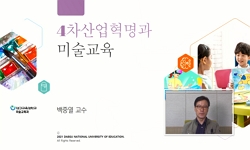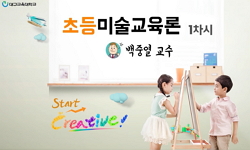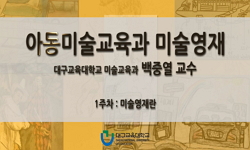현대 미술은 개인의 성별, 계급, 자아의 정체성 등에 관심을 두기 때문에 다양한 양식이 공존하고, 오브제를 통해 새로운 양식이 산출된다. 오브제는 예술작품의 형식과 재료, 예술의 사회적...
http://chineseinput.net/에서 pinyin(병음)방식으로 중국어를 변환할 수 있습니다.
변환된 중국어를 복사하여 사용하시면 됩니다.
- 中文 을 입력하시려면 zhongwen을 입력하시고 space를누르시면됩니다.
- 北京 을 입력하시려면 beijing을 입력하시고 space를 누르시면 됩니다.
오브제를 활용한 중학교 미술 교육 방안 연구 : 미켈 뒤프렌느의 미적 체험 이론에 기초하여 = A Study on Middle School Art Education through Object : Based on the Aesthetic Experience Theory by Mikel Dufenne
한글로보기https://www.riss.kr/link?id=T11547314
- 저자
-
발행사항
경산 : 대구가톨릭대학교 교육대학원, 2009
-
학위논문사항
학위논문(석사) -- 대구가톨릭대학교 교육대학원 , 미술교육전공 서양화 전공 , 2009. 2
-
발행연도
2009
-
작성언어
한국어
- 주제어
-
발행국(도시)
경상북도
-
형태사항
ⅴ, 44 p. ; 26 cm
- 소장기관
-
0
상세조회 -
0
다운로드
부가정보
국문 초록 (Abstract)
본 연구를 통해 뒤프렌느의 미적 지각 단계에 맞추어 오브제를 활용한 중학교 현대미술교육 현장에 투입하였다. 영화와 예술 작품을 수업 시작에 제시하여 1단계인 학습자의 감각적 지각을 도울 수 있는 다양한 감각적 내용을 제시하였고, 다양한 오브제를 준비한 뒤 오브제를 직접 고르고 선택하게하여 학생 각자가 대상을 향해 지향적 태도를 갖게 하였다. 2단계인 표상을 위한 상상력 지각의 단계에서 일반적 경험의 상상력을 절제하고 아이디어 스케치 단계를 통해 오브제를 새로운 의미로 재탄생시키는 과정을 거쳤다. 3단계인 반성 비평적 지각을 돕기 위해 스스로 표현하고 만든 예술작품들에 대한 구조적 이해와 내면적 반성을 통해 새로 탄생한 미적 대상물을 주변여러 학생들과 감상을 하였다.
이와 같이 실제 학교 미술교육에서도 미적 체험과 표현, 감상의 영역의 미술 교육이 골고루 이루어 질수 있음을 알 수 있다.
미술 교육은 삶의 영역에서 의미 있는 지각활동을 하게 함으로써 우리 자신과 다른 사람을 더 잘 이해하고 삶의 질을 높이는데 기여하게 될 것이다.
현대 미술은 개인의 성별, 계급, 자아의 정체성 등에 관심을 두기 때문에 다양한 양식이 공존하고, 오브제를 통해 새로운 양식이 산출된다. 오브제는 예술작품의 형식과 재료, 예술의 사회적 기능을 확대하며 전통예술의 범위를 해체한다. 오늘날 오브제는 다양한 형식으로 삶의 영역에 깊숙이 침투해있다. 따라서 일상의 모든 것은 미적 체험을 통해 미적 대상으로 거듭날 수있다. 뒤프렌느가 미적 체험에 대한 논의에 관심을 기울이는 것은 그가 인간에 대한 지속적인 관심에서 인간과 세계의 관계라는 문제를 중요하게 다루기 때문이다. 김화자2)는 미적 지각에 의한 미적 체험은 작품의 이해뿐만 아니라, 인간의 본래성을 회복시켜서 결국 우리는 각자의 ‘나’ 가 아닌 ‘하나의 우리’로서 타인들과 함께 살아가는 존재라는 인간주의적 의미를 지닌다고 말한다. 즉, 미적체험을 통한 미술교육은 단지 멋있기 위한 미술을 배우는 것에 제한되는 것이 아니라 올바른 미적 체험을 함으로써 개인과 우리가 살아가고 있는 공동체에 대한 이해를 하기 위해서 이다.
본 연구를 통해 뒤프렌느의 미적 지각 단계에 맞추어 오브제를 활용한 중학교 현대미술교육 현장에 투입하였다. 영화와 예술 작품을 수업 시작에 제시하여 1단계인 학습자의 감각적 지각을 도울 수 있는 다양한 감각적 내용을 제시하였고, 다양한 오브제를 준비한 뒤 오브제를 직접 고르고 선택하게하여 학생 각자가 대상을 향해 지향적 태도를 갖게 하였다. 2단계인 표상을 위한 상상력 지각의 단계에서 일반적 경험의 상상력을 절제하고 아이디어 스케치 단계를 통해 오브제를 새로운 의미로 재탄생시키는 과정을 거쳤다. 3단계인 반성 비평적 지각을 돕기 위해 스스로 표현하고 만든 예술작품들에 대한 구조적 이해와 내면적 반성을 통해 새로 탄생한 미적 대상물을 주변여러 학생들과 감상을 하였다.
이와 같이 실제 학교 미술교육에서도 미적 체험과 표현, 감상의 영역의 미술 교육이 골고루 이루어 질수 있음을 알 수 있다.
미술 교육은 삶의 영역에서 의미 있는 지각활동을 하게 함으로써 우리 자신과 다른 사람을 더 잘 이해하고 삶의 질을 높이는데 기여하게 될 것이다.
다국어 초록 (Multilingual Abstract)
Traditionally object was the subject of representation. Cubiists manipulated object in a plane, expanding the realms of fine art. Dadaists , employing object as a technique for representation not as a simple subject of representation, introduced object itself into fine art, shattering the border line between fine art and sculpture. The appreciation of modern art requires the understanding of object. Object also has deeply penetrated into various realms of modern life. Access to various object in modern life brings life to object as a subject of aesthetic experience. Mikel Dufrenne's emphasis on the aesthetic experience in modern life has much to do with his concern about humans and the world. Such aesthetic experience leads to appreciation of works of life and awareness of our being 'we as one' in our community by restoring the human aesthetic nature. The ultimate purpose of art education must be understanding humans and our community.
The current 7th Curriculum focuses on the art education of representation-only, failing to teach evenly the three scopes : aesthetic experience, representation, appreciation. In such context, aesthetic faculty and creative works can never be expected.
The instruction for this study was conducted as follows :
At the introduction stage, by presenting various object the learners' sensuous perception was evoked. By presenting object such as film or works of art or by letting learners select object, object-directed attitude was motivated.
At the second(representation or imagination) stage, restraining ordinary imagination, original and creative imagination about the object was stimulated through brain-storming sketch.
At the final(reflection and emotion) stage, by understanding the structure of the aesthetic creation in critical perspective and with inner reflection, students in groups were allowed to obtain the aesthetic value of the creation.
In view of this study, middle school art education can contribute to the cultivation of learners aesthetic nature by evenly-distributed activities of aesthetic experience, representation, and appreciation. Well-balanced art education, by employing object, can help understand humans and the world and contribute to promoting quality of life for learners.
The purpose of this study is to suggest a new improved art instruction method based on Mikel Dufrenne's aesthetic theory. The new method is to let learners have aesthetic experience with object, to cultivate the learners' aesthetic faculty and aesthet...
The purpose of this study is to suggest a new improved art instruction method based on Mikel Dufrenne's aesthetic theory. The new method is to let learners have aesthetic experience with object, to cultivate the learners' aesthetic faculty and aesthetic creativity. The essence of Mikel Dufrenne's esthetics is to grasp the underlying significance of aesthetic object by aesthetic experience through the three aesthetic perception stages - pre-representation, representaton, appreciation.
Traditionally object was the subject of representation. Cubiists manipulated object in a plane, expanding the realms of fine art. Dadaists , employing object as a technique for representation not as a simple subject of representation, introduced object itself into fine art, shattering the border line between fine art and sculpture. The appreciation of modern art requires the understanding of object. Object also has deeply penetrated into various realms of modern life. Access to various object in modern life brings life to object as a subject of aesthetic experience. Mikel Dufrenne's emphasis on the aesthetic experience in modern life has much to do with his concern about humans and the world. Such aesthetic experience leads to appreciation of works of life and awareness of our being 'we as one' in our community by restoring the human aesthetic nature. The ultimate purpose of art education must be understanding humans and our community.
The current 7th Curriculum focuses on the art education of representation-only, failing to teach evenly the three scopes : aesthetic experience, representation, appreciation. In such context, aesthetic faculty and creative works can never be expected.
The instruction for this study was conducted as follows :
At the introduction stage, by presenting various object the learners' sensuous perception was evoked. By presenting object such as film or works of art or by letting learners select object, object-directed attitude was motivated.
At the second(representation or imagination) stage, restraining ordinary imagination, original and creative imagination about the object was stimulated through brain-storming sketch.
At the final(reflection and emotion) stage, by understanding the structure of the aesthetic creation in critical perspective and with inner reflection, students in groups were allowed to obtain the aesthetic value of the creation.
In view of this study, middle school art education can contribute to the cultivation of learners aesthetic nature by evenly-distributed activities of aesthetic experience, representation, and appreciation. Well-balanced art education, by employing object, can help understand humans and the world and contribute to promoting quality of life for learners.
목차 (Table of Contents)
- Ⅰ. 서론 = 1
- 1. 연구의 목적과 내용 = 1
- 2. 연구의 방법 = 2
- Ⅱ. 오브제 = 3
- 1. 오브제의 개념 = 3
- Ⅰ. 서론 = 1
- 1. 연구의 목적과 내용 = 1
- 2. 연구의 방법 = 2
- Ⅱ. 오브제 = 3
- 1. 오브제의 개념 = 3
- 2. 오브제의 역사 = 3
- 3. 현대미술에 나타난 오브제의 유형과 기법 = 12
- 4. 오브제 수업의 교육적 가치 = 14
- Ⅲ. 미켈 뒤프렌느의 미적 체험 이론 = 15
- 1. 미적 체험 = 15
- 2. 미적지각 3단계 = 16
- 3. 미술 교육 방안으로써의 의의 = 17
- Ⅳ. 미적 체험에 기초한 오브제 미술교육 방안 = 19
- 1. 생활 주변 오브제의 수업 활용 가능성 연구 = 19
- 2. 오브제 활용 수업을 위한 학생 기초 조사 = 22
- 3. 오브제를 활용한 수업지도안 = 24
- 4. 수업적용 결과 = 33
- Ⅴ. 결론 = 36
- 참고문헌 = 38
- 참고도판 = 40












